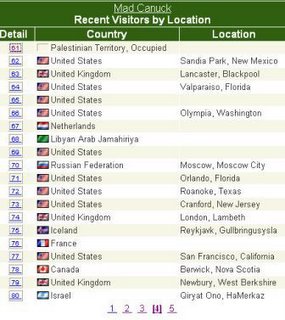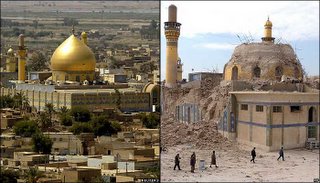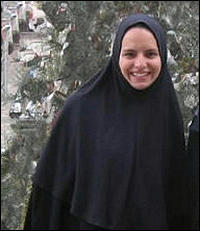Scroll down for updates.Original Post: February 4, 2006Over the past week or so, many parts of the Middle East have erupted in outrage at a series of twelve caricatures of the prophet Mohammed that were published in the Danish newspaper Jyllands-Posten back in September. This dispute has been simmering under the surface for some months, but really came to a head last week, with large protests, Danish companies boycotted, and Danish flags burned in the street.
When I first heard about the controversy, I wasn't quite sure what to make of it, and even today I remain somewhat ambivalent. On one side, several of the cartoons that Jyllands-Posten published strike me as racist and deliberately insulting, and as such, I cannot blame Muslims for being offended by them. However, on the other side, I think some parts of the Middle East have taken the backlash against Jyllands-Posten and against Denmark too far.
Before I get started, I should point out I'm a strong advocate of freedom of speech. However, it is important to realize that freedom of speech is a two-way street. Freedom of speech protects one's right to express an opinion, it does not protect one against the backlash that may result from doing so. For example, being here in New York, freedom of speech allows me to wear a Boston Red Sox jersey to Yankee Stadium, but I would probably find myself the brunt of jokes, insults, and abuse. And that's just a baseball game...
In the case of Jyllands-Posten, they decided to test the limits of freedom of speech by seeing how much they could get away with, rather like one might test the patience of one's neighbor by throwing a rock through his window or calling his mother a whore. They knew that drawing images of prophets in Islam is offensive, and they did it anyway as a deliberate insult. And if you think this wasn't deliberate, the caricatures were laid out in a
full-page spread, surrounding this explanation:
The modern, secular society is rejected by some Muslims. They demand a special position, insisting on special consideration of their own religious feelings. It is incompatible with contemporary democracy and freedom of speech, where you must be ready to put up with insults, mockery and ridicule. It is certainly not always equally attractive and nice to look at, and it does not mean that religious feelings should be made fun of at any price, but that is less important in this context. [...] we are on our way to a slippery slope where no-one can tell how the self-censorship will end. That is why Morgenavisen Jyllands-Posten has invited members of the Danish editorial cartoonists union to draw Muhammad as they see him.
According to this background article, Jyllands-Posten invited forty artists to submit drawings of Muhammad, and only twelve responded. Of the twelve carricatures, three of them drew Muhammad in a very respectful light:
- The face of Muhammad as a part of the Islamic star and crescent symbol. His right eye the star, the crescent surrounds his beard and face.
- Muhammad standing peacefully with a halo in the shape of a crescent moon.
- Muhammad as a peaceful wanderer, leading a donkey through the desert at sunset.
If Jyllands-Posten had stopped at these three cartoons, or had published another nine like them to make twelve, there would have been minimal or no controversy. Yes, Muslims consider drawing caricatures of Muhammad to be haram, but it is at least if they were all in good taste, things would not be that bad. But, Jyllands-Posten didn't stop there...
The next five cartoons were blatantly racist and stereotypical, and each seemed to be a very deliberate and calculated insult:
- Muhammad's head wearing a turban fashioned as a bomb, with a lit fuse and the Islamic shahada (creed) written in Arabic on the front of the bomb. This is the one cartoon that offended many Muslims, since it symbolizes that the entire net product of their religion is evil and murder.
- An abstract drawing of crescent moons and Stars of David, and a poem on oppression of women "Prophet! daft and dumb, keeping woman under thumb"
- Two angry Muslim warriors rush in with a sabre and a bomb, while Muhammad tells them, "Relax guys, it's just a drawing made by some infidel South Jutlander" (Dutch slang for someone from the "middle of nowhere")
- A crazed-looking Muhammad holding a dagger and with a black bar censoring his eyes. He is flanked by two panic-stricken women wearing niqaabs (veils covering all but their eyes).
- Muhammad standing on a cloud, greeting dead suicide bombers with "Stop, stop, we have run out of virgins!"
And then, as if to say to the world, "yes, we know we are stirring up a maelstrom here," the next four cartoons seem to poke fun of the predicament Jyllands-Posten were setting up for themselves:
- An olive-skinned boy in front of a blackboard, pointing to the Farsi writing, which translate into "the editorial team of Jyllands-Posten is a bunch of reactionary provocateurs". The boy is labelled "Mohammed, Valby school, 7.A".
- A nervous artist, shakingly drawing Muhammad while looking over his shoulder.
- The journalist Kåre Bluitgen, wearing a turban with an orange dropping into it, with the inscription "Publicity stunt". In his hand is a stick drawing of Muhammad. An "orange in the turban" is a Danish proverb meaning "a stroke of luck."
- A police line-up of seven people, with the witness saying: "Hm... I can't really recognise him". The guy on the right in the lineup is journalist Kåre Bluitgen, carrying a sign saying: "Kåre's public relations, call and get an offer".
In short, the entire exercise of Jyllands-Posten publishing these cartoons was a calculated and deliberate insult, which is one reason so many educated Muslims were offended by them. As Oliver Wendell Holmes once said, even a dog can tell the difference between being stumbled over and being deliberately kicked.
At the same time, I think many of the protests in the Middle East have gone too far. Protesting is okay, burning flags is okay, boycotting products is okay. In fact, all of those things fall within the same protection of "free speech" that protected Jyllands-Posten's right to publish the drawings in the first place. But, issuing death threats is not, and neither is calling for "death to Denmark", imploring al-Qaeda to bomb Denmark, or any other violence. I do hope people are able to work though this controversy without anyone getting killed over it.
Update: February 7, 2006Unfortunately, since I wrote this post, the lunatic fringes seem to have come out on both sides of this debate. On one side, the Islamic lunatics have latched onto this issue, burning embassies, issuing death threats, clashing with police, trashing neighborhoods, and one alleged murder case in Turkey. On the other side, we have the lunatics in Europe and America who insist on stoking the fire by printing more copies of these offensive carricatures.
To both sides: give it a rest!
To those in the West: As I mentioned earlier in this post, these cartoons are not nice, they were commissioned as a calculated insult to all Muslims around the world (not just the fanatical ones). Jyllands-Posten had the legal right to publish these photos, but did it have the moral right? Just because you CAN do something doesn't mean you SHOULD. For other newspapers to go on printing these cartoons again and again is only perpetuating this insult and dragging this whole issue out.
And, to the Muslims around the world: Freedom of speech is a good thing, and just like Jyllands-Posten had the right to publish these cartoons, you have the legal right to express your outrage at it. But freedom of speech has its limits in that it should not be used to foment violence. Freedom of speech is cool; protesting is cool; boycotts are cool. However, burning embassies, calling for the beheading of people, and inciting terrorism are not cool - not cool at all.
It seems some of these protests are starting to get out of hand, and perhaps Muslim religious leaders should be trying to put this issue to bed soon. You've made your point, and with a few exceptions, generally done so peacefully, and shown the world that you can stand together and make a point without large amounts of death, violence, or terrorism. If you call it a day now, and make a peaceful end to these protests, you've proven the cartoons wrong about you. I'd suggest, it's time to call it a day.
 One thing I have noticed is that over the past few months, this blog has gotten more visitors, and my visitors have been getting more diverse. A few months ago, almost all my visitors were from the US and Canada, while these days, I have regular readers in the United States, Canada, Britain, Iraq, Finland, Israel, Palestine, France, Russia, Iceland, Australia, Libya, New Zealand, the United Arab Emirates, and even Iran.
One thing I have noticed is that over the past few months, this blog has gotten more visitors, and my visitors have been getting more diverse. A few months ago, almost all my visitors were from the US and Canada, while these days, I have regular readers in the United States, Canada, Britain, Iraq, Finland, Israel, Palestine, France, Russia, Iceland, Australia, Libya, New Zealand, the United Arab Emirates, and even Iran. Add Taiwan into the list of countries I mentioned above. "Trebuchet" - thanks for the link!
Add Taiwan into the list of countries I mentioned above. "Trebuchet" - thanks for the link!









